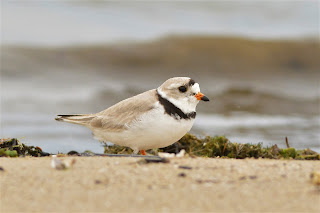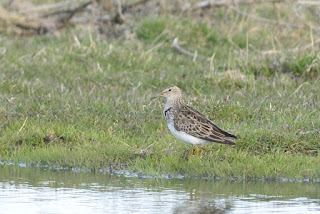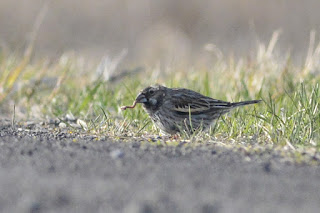On the morning of April 24th I awoke before 6:00am in a parking lot near Point Pelee, where I had slept in my car the previous night. Campenelli was still snoring logs in the passenger seat. I rolled down the window and was greeted by warm air and the sounds of the predawn songbird chorus. Granted, this early in the season there are not a ton of birds singing (robins, blackbirds, Brown Thrasher, Song Sparrow etc) but there was just a feeling of excitment in the air. I was up late the night before watching the live updates on Birdcast, a website put out by the Cornell Lab that shows maps with real time information about the migrating birds (direction, height, speed, overall numbers). It was evident at that point that birds were moving en masse, and they were headed northwards. I had been watching various weather models all week and I had high hopes for Sunday, as from what I could tell it was shaping up to be the best day of 2022 so far in terms of migration. A few minutes later I was driving down the road through Point Pelee headed towards the tip. Even though it was still quite dark, I could see lots of birds in the cars headlights flying off the road. Most couldn't be identified beyond "sparrow sp" or "thrush sp". but it was clear that a lot of birds had arrived the previous night. As I was coming up towards the VC, I was disappointed to see that the road to the tip had a gate across it, doh. I was spoiled, having been able to drive down there every time I had visited this spring and because of this I just assumed it would be open on the weekend too.
After getting my gear together I started quickly making my way down the road, as sunrise was fast approaching and the tip was over 2 kilometers away. Only a few hundreds meters down the road a Swainson's Thrush popped up, a yearbird and also a bit early for this date. The forest was alive with activity. A Black-throated Green Warbler sang, two Nashville Warblers and Chimney Swift flew over and Yellow-rumped Warblers, sparrows and thrushes were moving through the understory. It was hard staying on task (continuing to walk) as I could have easily walked down any of the side trails and gotten distracted. Near the tower at the tip a Tennessee Warbler buzzed by, and a Least Flycatcher popped up from beside the trail. I wasn't even at the tip yet and I had already seen 6 yearbirds... yes, it was going to be a good day.
Nathan Hood had arrived a bit before us and met us at the tip. Immediately we were in the middle of the action, as songbirds were reverse migrating off the tip in large numbers. Flocks of 10, 15 Chipping Sparrows and large numbers of Yellow-rumped Warblers dominated the flight, but there were lots of other things mixed in. William Konze and Luke Raso arrived a few minutes later and joined in the watch, as numbers of birds continued to grow. Balitmore Oriole, Orchard Oriole, Scarlet Tanager, Blackburnian Warbler, Northern Parula... I was starting to lose track of yearbirds they were coming so fast. Then a young male Summer Tanager reversed off the tip right beside us, my first time seeing this species in morning flight... and also a code 3 yearbird. A few minutes later I got on a lanky sparrow type bird flying by... Lark Sparrow! I rattled off a few shots before it disappeared. It flew by a few minutes later for a 2nd pass, then left for good and flew out over Lake Erie. This was another code 3 rarity, and a new self found bird for me. I'm just going to list the reverse highlights below, because there were just so many.
yearbirds denoted with *
- 13 Chimney Swifts*
- 7 Spotted Sandpipers
- 1 Lesser Yellowlegs
- 4 Forster's Terns
- 40 Northern Flickers
- 7 Eastern Kingbirds*
- 8 Blue-headed Vireos*
- 4 Warbling Vireos*
- 250 Chipping Sparrows
- 9 Field Sparrows
- 1 Lark Sparrow
- 4 Orchard Orioles*
- 8 Baltimore Orioles*
- 9 Nashville Warblers*
- 3 Northern Parulas*
- 3 Blackburnian Warblers*
- 15 Yellow Warblers
- 25 Palm Warblers
- 3 Pine Warblers
- 150 Yellow-rumped Warblers
- 5 Black-throated Green Warblers*
- 1 Summer Tanager*
- 3 Scarlet Tanagers
- 3 Rose-breasted Grosbeaks
- 3 Indigo Buntings
Crazy stuff!!
Some photos below....
 |
| - Summer Tanager |
 |
| - Northern Flicker (look at the single red primary) |
 |
| - Indigo Bunting |
 |
| - Blackburnian Warbler |
 |
| - Lark Sparrow |
 |
| - Yellow Warbler |
 |
| - Scarlet Tanager |
 |
| - Rose-breasted Grosbeak |
 |
| - Baltimore Oriole |
 |
| - Eastern Kingbird |
 |
| - Chimney Swift |
 |
| - Northern Flicker |
 |
| - Orchard Oriole |
 |
| - Northern Parula |
 |
| - Black-throated Green Warbler |
 |
| - Palm Warbler |
Around 9:30am the action started to quiet down a bit, so reluctantly I tore myself away from the tip and headed back into the park in search of more migrants in the forest. Walking past Sparrow Field into North Woods, I saw Golden-winged Warbler, Blue-winged Warbler, Common Yellowthroat, Lincoln's Sparrow and Veery, all yearbirds. After another few minutes of walking down the trail a few birders were pointing to a nearby tree... where an Eastern Whip-poor-will was perched. Always a fun species to get "face melting" views of. Swainson's Thrushes were around in numbers, actually outnumbering hermit. Kind of crazy seeing none were there the previous day, goes to show just how many birds came in the previous night.
 |
| - Eastern Whip-poor-will |
 |
| - Golden-winged Warbler |
 |
| - Same beast |
 |
| - Blue-winged Warbler |
 |
| - Lincoln's Sparrow |
I spent the remainder of the morning birding around the park with Nathan and Ezra, and although activity was quieting down a bit there were still lots of birds. Interestingly a lot of the neotropical migrants were only seen in reverse off the tip in the morning, not at all in the park itself. By 1:00pm I had seen 106 species, pretty good for April 24th!
On Friday a Western Tanager was found 20 minutes away from my house on the Bruce. It was only seen at a feeder for a few minutes though and the homeowners never saw it again. Then late Saturday afternoon it was seen at another bird feeder around 4 kilometers away from the first spot. It was too late in the day to get back up from Pelee, so we decided to chase it on Sunday if it was refound. I didn't want to go up in the morning and miss Pelee, a decision that I am very glad I made. Anyways late Sunday morning news came in that the tanager had been refound, so reluctantly I left Pelee with Ezra around 1:30 and headed north. Of course after we left a Kentucky Warbler and a Western Meadowlark (among others) were found, but that's just how the game goes sometimes. The drive seemed to go by fast and just after 6:00pm we pulled onto the road on Stokes Bay. William and Luke had travelled up to chase it as well, and had beat us there by around 20 minutes. They had enjoyed spectacular views of the bird, but of course it flew off 10 minutes before we arrived. A tense 35 minutes passed, then finally the Western Tanager flew out and landed on the feeder. This was a code 4 rarity, and also a lifer for me... with the added bonus of being in my home county. The timing was perfect, as it then started raining and the wind picked up, so we headed off. Big thanks to the homeowners for allowing a lot of birders to walk around their property and stare at their feeder, it's friendly folks like this who are important during a big year... A few yards with no access can mean one or two less birds at the end of the year. In an interesting twist of fate, Josh Vandermeulen got a Western Tanager on his big year in 2012 only a few kilometers from this spot, also in late April.
 |
| - Western Tanager |
3 Tanager day!!
Ontario yearlist @ April 24th - 241

























































